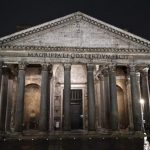150 YEARS OF THE NAZARETH SISTERS
In the footsteps of Blessed Frances Siedliska in Rome (21)
Sr. M. Beata Rudzińska, CSFN

Pantheon
Before walking with Frances Siedliska to her next place of residence, we should stop for a moment more at an unusual Roman monument, a fragment of which we can already see from Piazza Minerva, the Pantheon. It is likely that Frances also saw it well from the windows of the house where she lived after arriving in Rome.
The name of this temple is derived from Greek and means a place dedicated to all gods. The present building, founded by Emperor Hadrian in 125 B.C., stood on the site of an earlier one, dating from 27 B.C., destroyed by the famous fire of Rome during the time of Nero. Only the portico supported by 16 columns, each weighing 60 tons, remained of it.
The Pantheon is the only building in ancient Rome that remained intact in its construction and has been functioning for two thousand years. This was most likely because at the beginning of the 7th century it was handed over to the Pope and turned into a church dedicated to Our Lady of Martyrs. The Pantheon, therefore, is not only a work of architecture, the mausoleum of the first kings of a united Italy, but a Catholic temple where the liturgy is celebrated.
The dome of the Pantheon is the most remarkable part of the building. With an inner diameter of 43.44 meters and a weight of 5,000 tons, it is the largest ever built of unreinforced concrete (larger than the dome of St. Peter’s Basilica or the Hagia Sophia in Istanbul). It is a lasting testament to the genius of Roman architects, which no one dared to repeat for 1,300 years.
The construction of the dome was made possible by a number of solutions that contributed to the lightness of the structure: from coffers to the use of increasingly lighter materials mixed with concrete in the highest parts of the dome (brick flakes, tuff, volcanic lava and even hollow terra cotta vases). The thickness of the wall is also tapering off: from 5.90 meters at the base to 1.50 meters at the top.
The only source of light in the temple is an 8-meter-wide opening (oculos) in the dome, which has no cover. The temple’s slightly concave original floor has a barely noticeable drainage system for rainwater that can enter through the oculos.
In the Pantheon found a resting place for one of its restorers – Raphael Santi, the most famous, next to Michelangelo and Leonardo da Vinci, artist of the Italian Renaissance. A very religious man, he was hailed as a genius during his lifetime and called a divine artist. He died on Good Friday after an attack of fever at just 37 years old. Despite his short life, he left behind many works that we know today from religious cards and posters, not always realizing who their author was.
Pictures:
Portico and Oculos – Sr. Anita Jach CSFN
Columns and walls of the Pantheon – Sr. Beata Rudzińska CSFN
Raphael Santi, Nuptials of Mary and Joseph – Public Domain
Raphael Santi, Sistine Madonna – Public Domain






